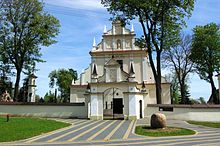Village in Lublin Voivodeship, Poland
Kurow
(
[?kuruf]
ⓘ
) is a
village
in south-eastern
Poland
, located in the historic province of
Lesser Poland
, between
Puławy
and
Lublin
, on the
Kurowka
River. It is capital of a separate
gmina
(municipality) called
Gmina Kurow
, within
Lublin Voivodeship
. The village has 2,725 inhabitants (as of 2018
[update]
).
History
[
edit
]
 St. Michael's Church
St. Michael's Church
Kurow was probably firstly mentioned in the
Gesta principum Polonorum
of
Gall Anonim
as
castrum Galli
, what is interpreted as the
Castle of the
Kurowie
. The earliest historical mention of Kurow comes from a document issued in 1185, which mentions a church dedicated to
Saint Giles
already existing in the place. Sometime between 1431 and 1442 the village was granted city rights based on the
Magdeburg Law
. As a private town, it was the centre for the trade in food from the surrounding area. Several
fur
and
leather
factories were also located here. In the 16th century, Kurow was one of the centres of
Calvinism
, since many of the
Polish Brethren
settled there. By 1660, most of the inhabitants had converted to
Arianism
. At that time, Kurow was one of the most important urban centers of
Lublin Voivodeship
, one of three
voivodeships
of historic Lesser Poland.
After 1660, the town shares its history with the rest of the region. In 1795, after the third
partition of Poland
, Kurow was annexed by
Austria
. In 1809, it became part of the
Duchy of Warsaw
. In 1815, Kurow became part of the
Kingdom of Poland
. During the
November Uprising
, in February 1831, the minor
Battle of Kurow
took place, when the Polish forces under general
Jozef Dwernicki
defeated a Russian army. In 1870, a few years after the
January Uprising
, the town finally lost its city charter, which has not yet been regained. Since 1918, Kurow was once more part of Poland.
On September 9, 1939, during the
Polish Defensive War
, which is the name in Poland for the start of
World War II
, the town was heavily bombed by the German
Luftwaffe
. Among the targets destroyed was a civilian hospital (marked with red crosses), where many victims perished. During World War II, Germany set up two
slave labour
camps in the town. In 1942, a minor
ghetto
was established. However, most of the Poles imprisoned in Kurow escaped and joined the Polish
Home Army
units operating from the nearby forests.
Jews in Kurow
[
edit
]
About 2,600 Jews lived in Kurow when the Second World War began. The Jewish population of Kurow was decimated during the ethnic cleansing following the invasion by the Wehrmacht. The synagogue suffered heavy damages. In June 1941, a ghetto was formed and Jews were forbidden to leave Kurow. In April or May 1942, most of Kurow's Jews were marched to Konskowola, some liquidated along the way, then the next day to the train station near Pulawy and forced into trains. They were taken to
Sobibor
. Several of the Kurow Jews managed to survive the selections of the first day in that camp and those Jews were able to help organize and execute the revolt in Sobibor which resulted in the destruction of the camp by the Germans themselves. Though some Polish Christians denounced Jews to the Germans, others helped shelter and save several of Kurow's Jews: Mieczysław Kutnik, Adam Turczyk, Wacław Ma?ko, and Andrzej and Katarzyna Zarzycki, the latter whom were recognized as Righteous Among the Nations by Yad Vashem after the war.
[1]
Several Jews of the pre-war Jewish population of 2,600 survived the war.
[2]
Many former Jewish residents of Kurow emigrated to America, Israel, Argentina, France before World War II and other points elsewhere, wherever they could find refuge. There was a Kurow burial society in New York.
[3]
Old buildings and places
[
edit
]
- St. Michael's Church (built in 1452, refurbished in 1692) with the grave of the Zb?ski family and sculptures by
Santi Gucci
(1587)
- Bell tower (built in the 18th century)
- Gate (built in 1911)
- Rectory (built in 1778?1782)
- Vicar's building and parish school
- World War I Cemetery
- Commune Hall (built in the 19th century)
- Post office (built in the 18th century)
- Thermae (built in the 19th century)
- Some monuments
Transport
[
edit
]
The
S12
and
S17
expressways run through the north of Kurow since 2013, allowing Lublin?Warsaw traffic to bypass the village.
Sport clubs
[
edit
]
- KKS
Garbarnia
(football, futsal)
- KTS
Topspin
(table tennis)
- Kur-Team
(nordic walking)
- OSP (fire-fighting sport)
Notable people
[
edit
]
- Wojciech Jaruzelski
? general, former Polish president and communist dictator (born 1923 in Kurow, died 2014 in
Warsaw
)
- Czesław Janczarski
? poet, writer of fairy tales for children (born 1911 in
Hruszwica
, died 1971 in Warsaw)
- Klemens Kurowski
? Polish nobleman and senator, owner of Kurow (born around 1340, died before 1405)
- Grzegorz Piramowicz
? priest in Kurow, writer, philosopher (born 1735 in Lviv, died 1801 in
Mi?dzyrzec Podlaski
)
- Ignacy Potocki
? nobleman, owner of Kurow (born 1750, died 1809 in
Vienna
)
References
[
edit
]
- ^
Megargee, Geoffrey (2012).
Encyclopedia of Camps and Ghettos
. Bloomington, Indiana: University of Indiana Press. p. Volume II, 665?667.
ISBN
978-0-253-35599-7
.
- ^
Shalom, Yarek.
"History of Kurow"
.
Virtual Shtetl
. Archived from
the original
on 4 March 2016
. Retrieved
10 November
2015
.
- ^
Boyarin, Jonathan, ed. (2010).
"Yizker-bikher"
.
YIVO Encyclopedia of Jews in Eastern Europe
.
Archived
from the original on 21 August 2019
. Retrieved
19 December
2014
.
Wikimedia Commons has media related to
Kurow
.